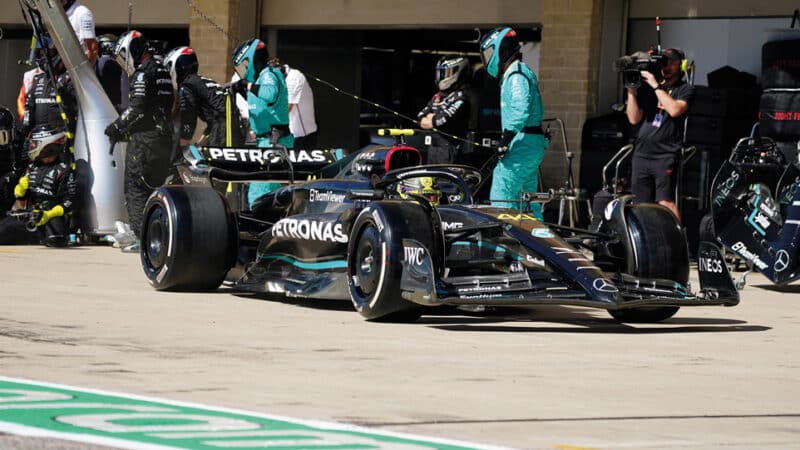How Mercedes threw away the chance of Lewis Hamilton victory in 2023 US Grand Prix
At COTA, Mercedes had a chance of its first victory of the season. Mark Hughes explains how its tyre strategy for Lewis Hamilton backfired... not that it mattered in the end

Lewis Hamilton was bouyant about his chances at Austin but his car’s tyres and underfloor plank were his undoing
Getty Images
There was an agonising decision on the Mercedes pitwall on lap 16 of the US Grand Prix which in hindsight they got wrong. It possibly cost Lewis Hamilton the team’s first win of the season. At that point Hamilton was running second to Lando Norris’s McLaren and around 4sec ahead of Max Verstappen’s Red Bull. Thermal degradation of the rear tyres is always the race day limitation around this place and everyone came into it expecting to stop twice. The pitstop loss here is 21sec and even stopping twice requires the driver to manage the tyres.
The two best cars on tyres are the Red Bull and Mercedes. Norris was leading the race but it was apparent that the McLaren’s tyre deg was higher and that he looked sure to be caught by both Hamilton and Verstappen. When Red Bull brought Verstappen in on lap 16, he was 4sec behind Hamilton and 7sec off Norris. His medium tyres were exchanged for a fresh set of the same, confirming he would need to stop again to meet the two-compound obligation. McLaren responded a lap later with Norris and switched him to the hards. It was a slower tyre but McLaren had no fresh mediums left, having used up an extra set in practice.
“In the sprint event you have to commit before which compound to use in first practice,” explained McLaren’s Andrea Stella. “Our car normally works very well on the harder compounds. You don’t know whether the mediums will grain or not. So we started practice on the mediums to save the hards. But once you’ve done that, and you’ve made the wrong choice, you are a set down of the better tyre. And that’s what we did. If we’d had another set of mediums it would have been better for our race but it would not have changed the result.”
“I think we made our life a lot harder than it needed to be”
Mercedes, like Red Bull, had got the tyre call right but as Verstappen and Norris made their first stops it was now faced with a tough choice. The instinctive thing would have been to cover off Verstappen’s stop by coming in on the next lap. That would have reduced that 4sec advantage to around 2sec, but Hamilton would still have had track position. Verstappen would have to pass either on track or at the second round of stops. But Mercedes didn’t do that.
The day before, Hamilton had been beaten in the sprint race by Verstappen who had pulled out 9sec in just 19 laps. He was currently behind because of his poor grid slot and was surely just pacing himself to look after the tyres. Convinced it would be beaten by Verstappen if it did the same strategy, Mercedes questioned if a one-stop was feasible. Could Merc’s 21sec saving of not making a second stop be overcome by Verstappen?

Regardless of Hamilton’s disqualification, his performance was a positive in the US
Getty Images
As Verstappen pitted, the numbers said that if Hamilton could maintain his current pace for another five laps, it would be feasible. There was nothing suggesting that the pace was dropping off. He was asked if he thought he could get to lap 23. He was ambivalent in his response. The pitwall decided to call it; they’d try for the one-stop. The first two of his targeted five more laps went well enough. But the tyres died on the third of them. He was suddenly 1.5sec off the pace and getting slower. The small window of a one-stop working was gone. Before it was too late, Merc backed out of it, bringing him in on lap 20. But those four extra laps had cost almost 8sec to Verstappen, who was now up to second without having had to go wheel-to-wheel with Hamilton.
If they had just covered Verstappen, Hamilton would have needed – on his slower hard tyres – to have kept the medium-tyred Verstappen behind him for the second stint. Which may have been a tough ask. But not impossible, given the brake problems of the Red Bull driver. “I’m not saying it was certain,” said Hamilton. “But I do think we would have been in a fighting position with Max. I think we made our life a lot harder today than it probably needed to be. I think it was probably going to be hard anyways, but…”

